Table of Contents
Today, we delve deep into a unique and powerful genre within this world – Aztec Warrior Tattoos. Resilient, courageous, and adorned with rich symbolism, these tattoos embody an age-old civilization’s core values and stories, offering profound expressions of identity and resilience.
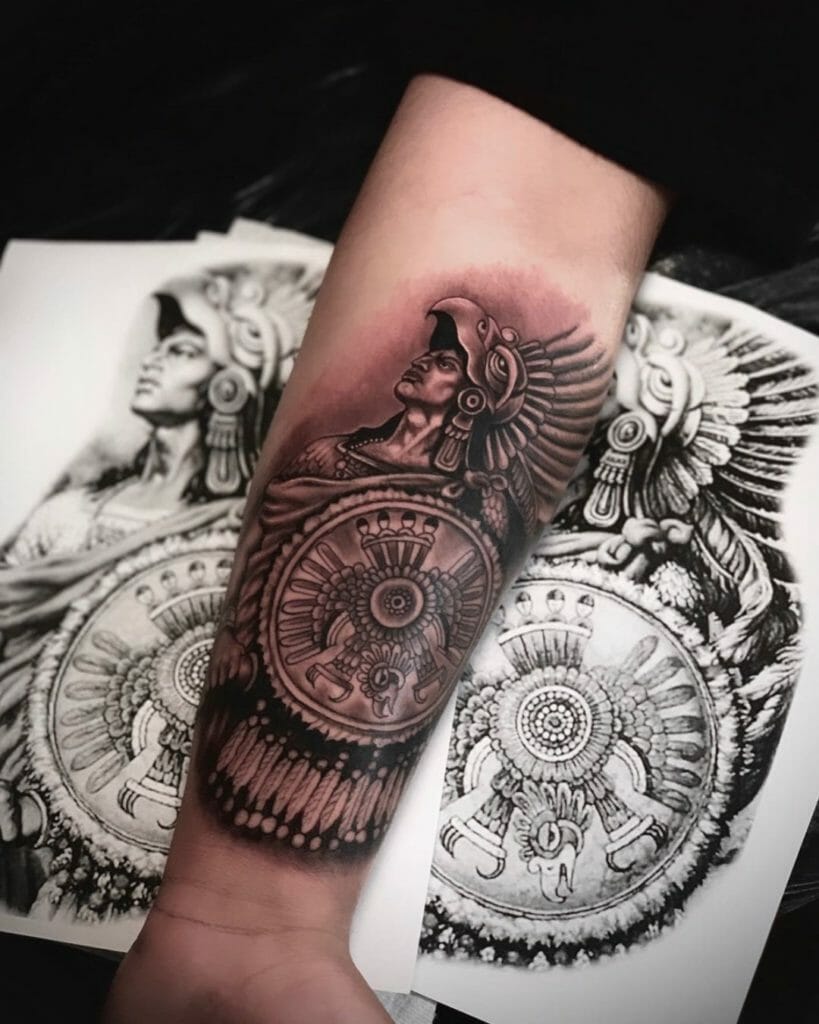
This blog post will unfold the intricate world of Aztec warrior tattoos, where history meets art, and symbolism intertwines with personal expression. Herein, you will gain insights into the meanings behind the popular Aztec Warrior symbols, helping you appreciate the depth of thought that goes into every detail of these intricate designs. In addition, we will present a curated selection of Aztec Warrior tattoo ideas, a testament to the ageless appeal of this tattoo genre.
Furthermore, we will explore the Aztecs’ rich cultural and historical context, deepening our understanding of the significance behind these remarkable symbols. We’ll delve into the warriors’ pivotal role within the Aztec society, the profound beliefs they held, and how these elements translate into today’s tattoo artistry.
Whether you are a tattoo enthusiast, an art lover, a history buff, or considering an Aztec Warrior tattoo for yourself, this post will provide you with a comprehensive overview and inspire your own journey of personal expression. Through the lens of Aztec Warrior tattoos, we witness not just a fascinating aspect of tattoo culture, but also a profound glimpse into the human spirit’s timeless capacity for resilience, courage, and the pursuit of purpose.
Bold Aztec Tattoos For Brave Warriors
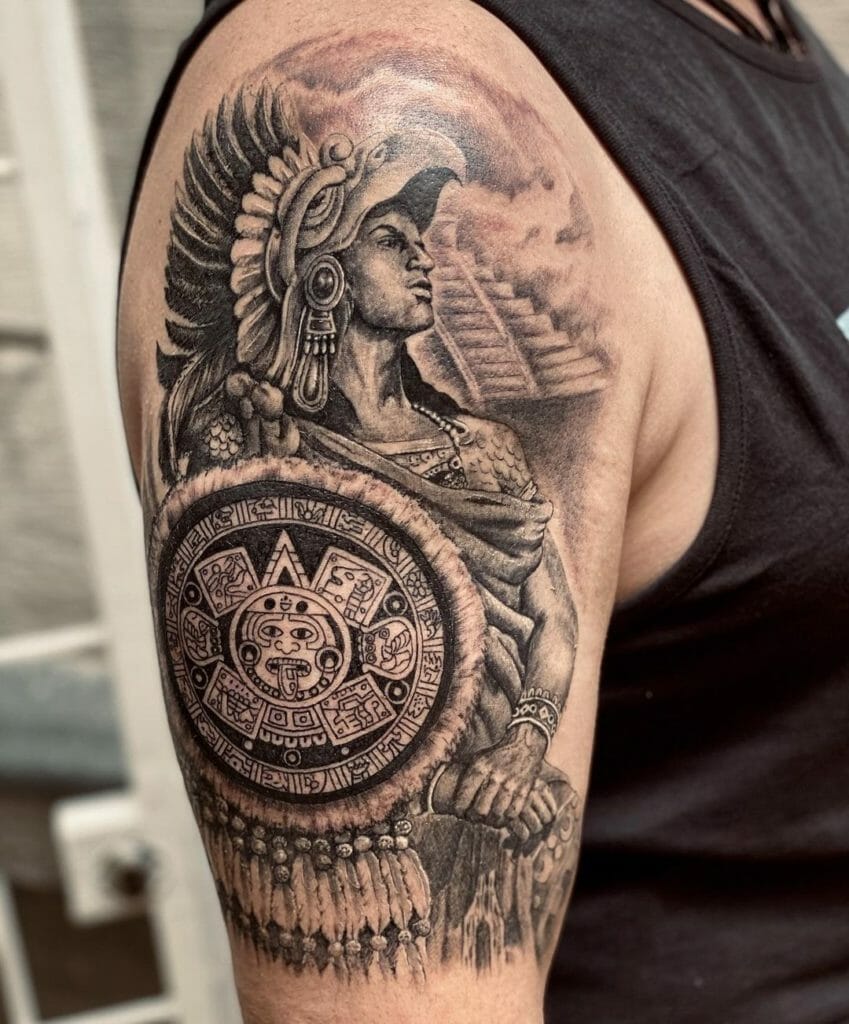
Delving into the realm of Aztec tattoos, one of the prominent designs is that of a formidable Aztec warrior, fully armed and accoutred. The notion of inscribing a determined and fierce warrior’s face might sound simplistic at first glance, but the process of crafting this intricate tattoo design is quite complex. As tattoo artists, we invest meticulous attention to detail, from feathered headdresses to ornate shield designs, transforming mere ink on skin into a powerful testimony of this tattoo style’s realism and popularity.
.
Unique Tattoo Design Of The Ferocious Warriors
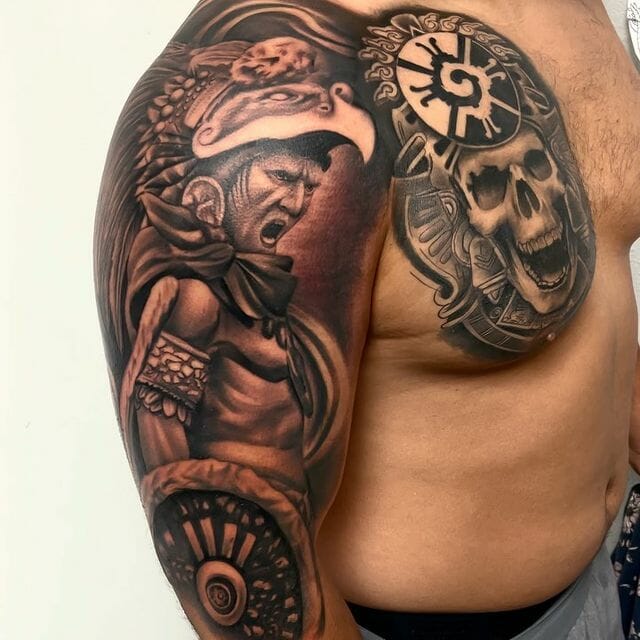
For those desiring an added layer of complexity, consider intertwining the symbol of the Aztec Sun God within the warrior’s shield. This deity, contrary to popular belief, was not merely a sunshine distributor, but also the Aztec God of War. Many warriors inscribed his symbol on their shields, seeking divine favor on the battlefield. Following their footsteps could animate a piece of history on your skin.
Complex Aztec Tattoo Representing The Animals And Birds Of The Culture
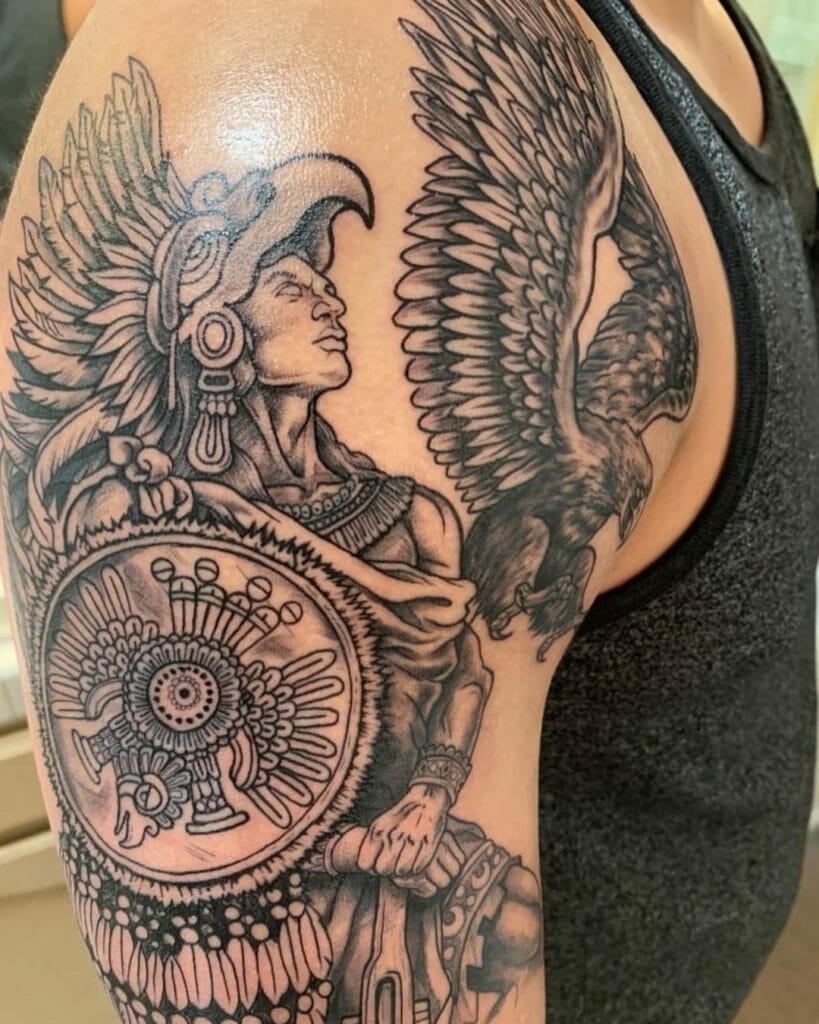
Perhaps you’re seeking a unique expression, a deviation from the norm? Some enthusiasts prefer depicting warriors mid-battle, their faces radiating courage and resolve. The world of tattoos embraces diversity, allowing for a blend of Aztec warriors with elements from other cultures like the intricate Vegvisir designs. It’s crucial to remember that Aztec culture fostered a deep connection with nature, particularly animals and birds. From serpents and eagles to hummingbirds, each creature bore significant symbolism, with many perceived as earthly avatars of their gods.
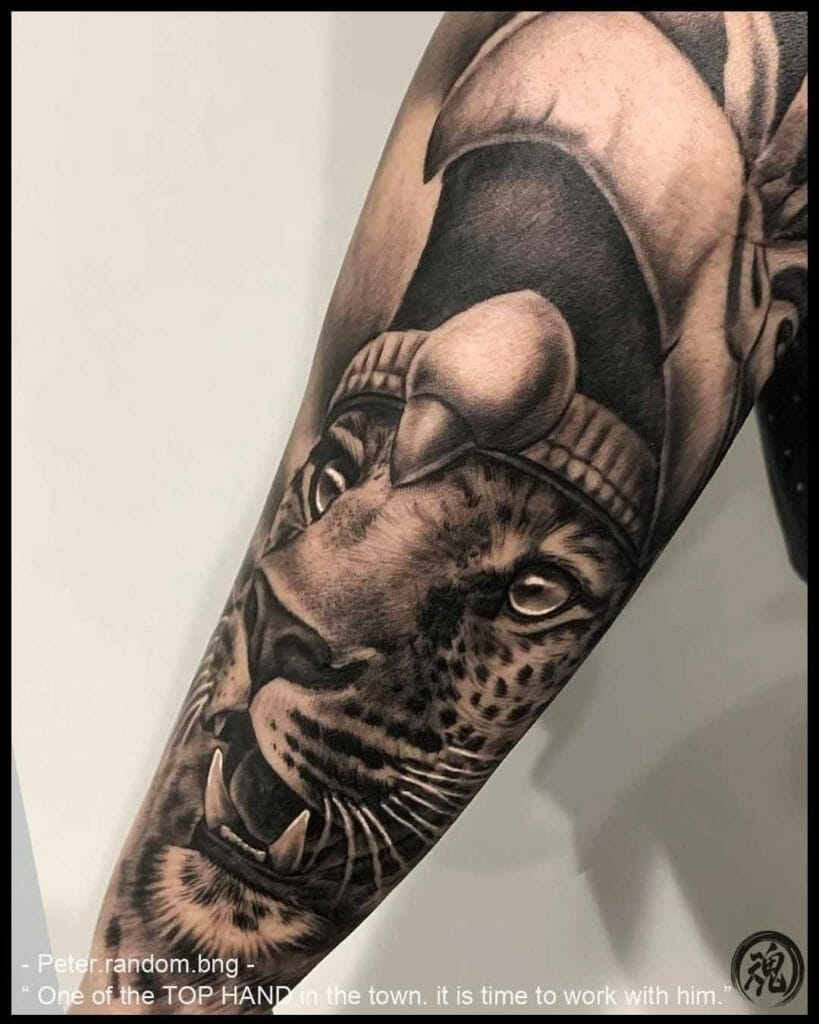
Ideas For Aztec Tattoo That Can Be Placed Anywhere
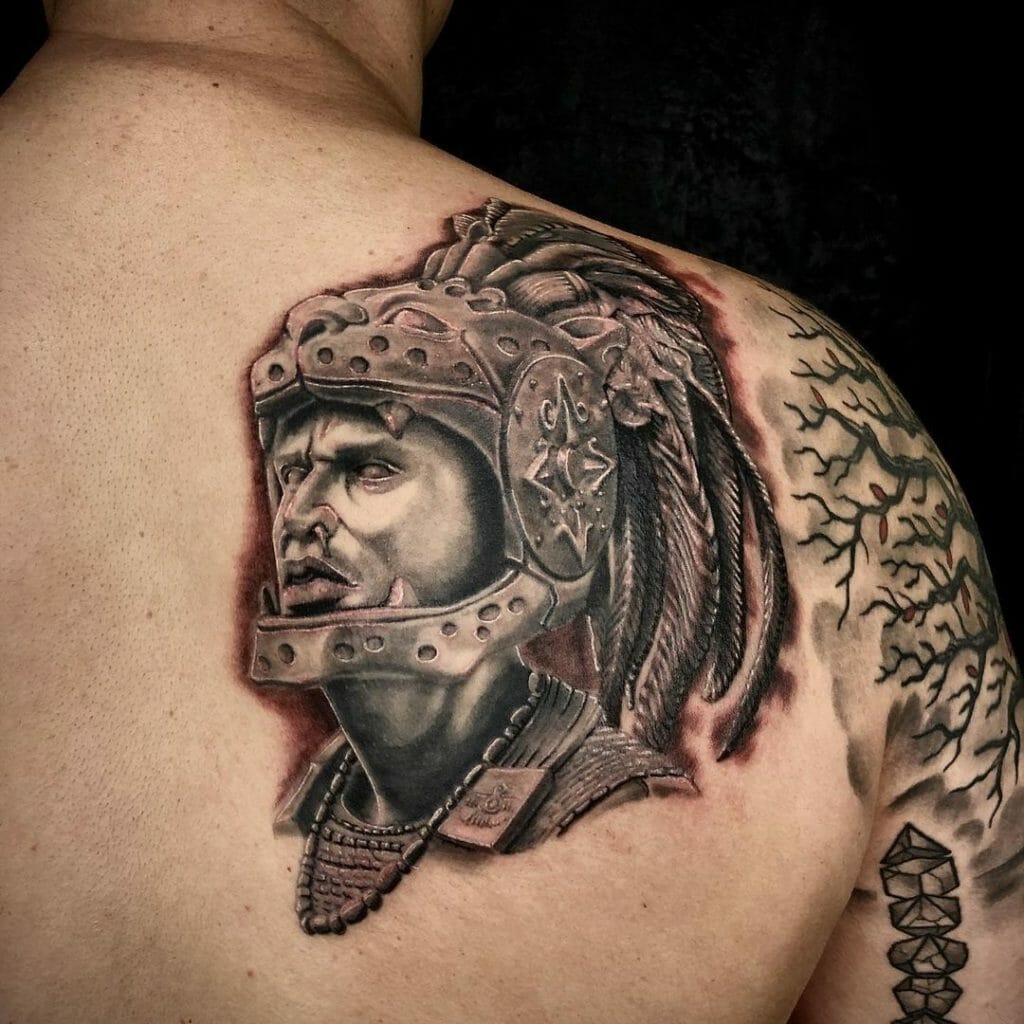
The Aztec eagle tattoo, symbolizing strength, power, and unlimited courage, is a majestic choice. Representing both the Sun God and the God of War, an Aztec eagle warrior tattoo offers a historically accurate piece for those aspiring to honor the ancient warriors. Alternatively, consider the mighty jaguar, a creature highly revered in Central America for its power and stealth. An Aztec jaguar warrior tattoo harmoniously blends traditional headdress elements with the regal beast’s fierce face, creating a unique metaphor for your inner warrior.
Ideas To Add Colours To Your Tattoo
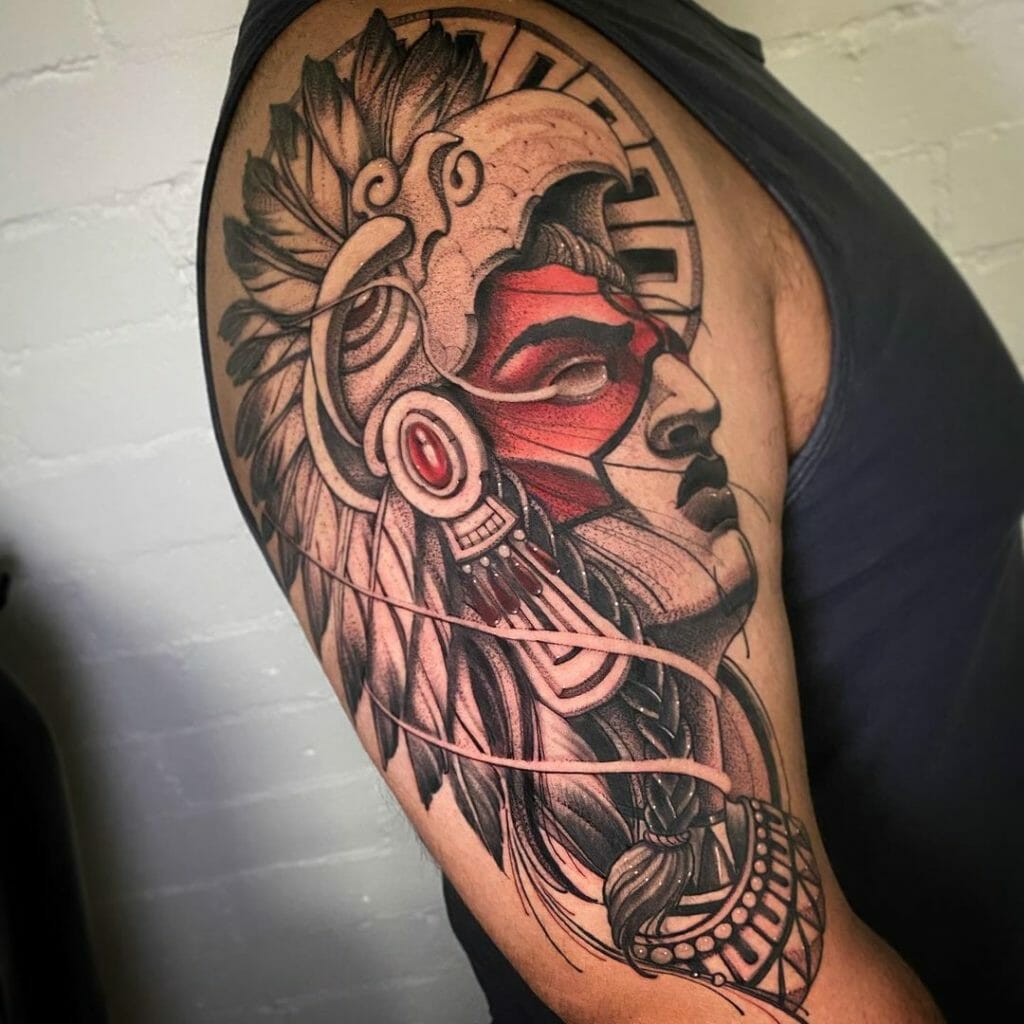
Ever considered enlivening your tattoo with colors? While popular tattoos tend to lean towards monochromatic, recent trends celebrate vibrant hues. Colors bring dynamic, lively layers to your tattoo, making it stand out from the crowd. Reflect on the Aztecs’ colorful lives and the vibrant feathered headdresses they wore. By delving into Aztec design history, you may discover colors that resonate with you and reflect their ancient symbolism.
Aztec Warrior Tattoo Design With The Skull Symbol
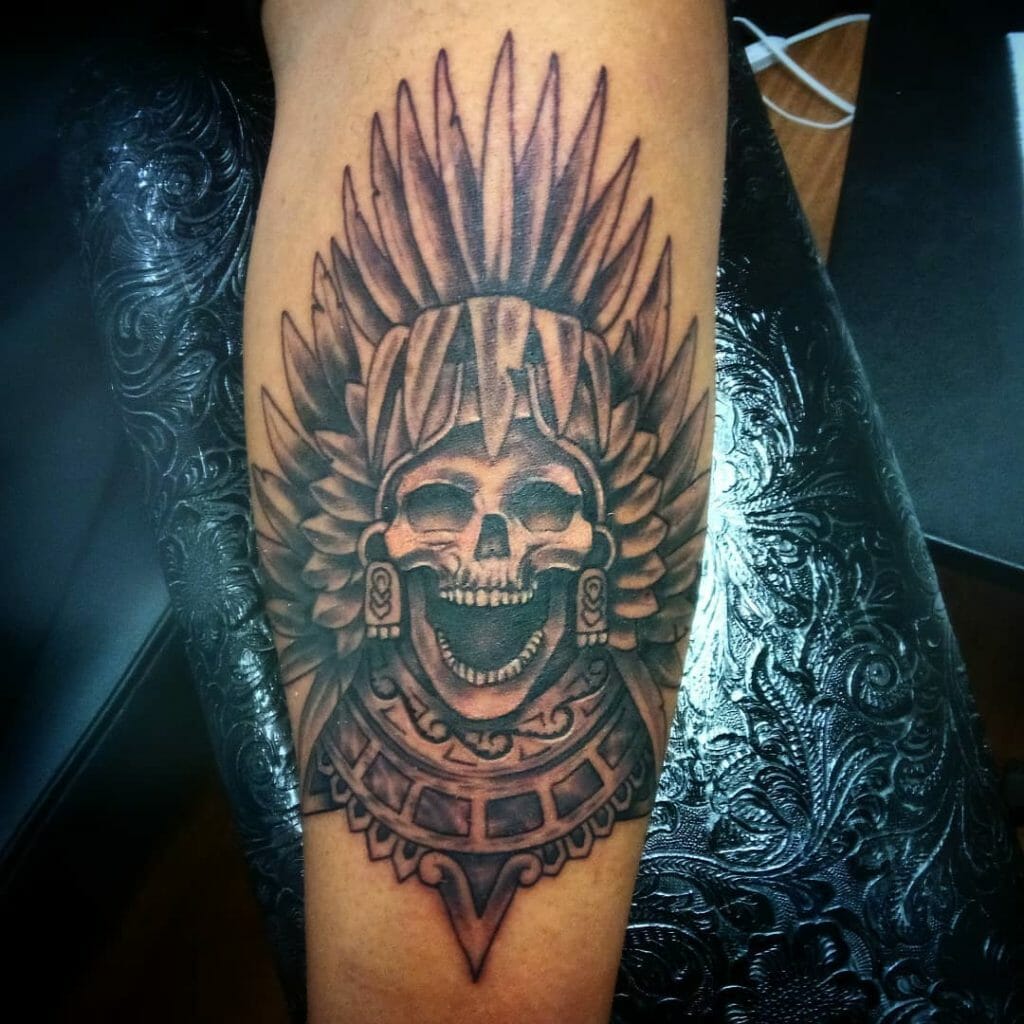
If you’re drawn to the edgier side of Aztec tattoos, consider the skull motif. These symbols serve as chilling testaments to the Aztecs’ victories and sacrifices. A skull Aztec tattoo, when blended with elements of the Aztec calendar, like headdresses or architectural designs, delivers a powerful statement.
How To Add The Shading Effect To Your Aztec God Tattoos
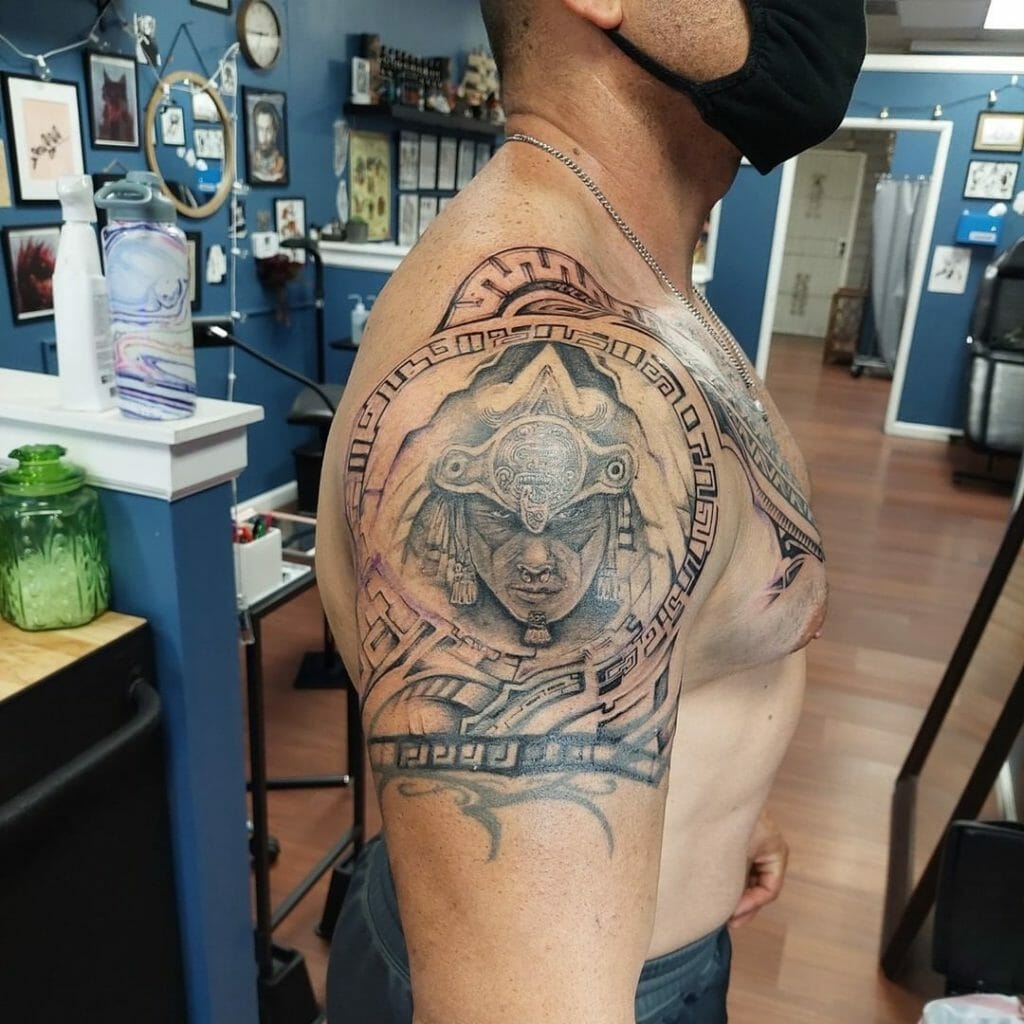
Shading and sketching techniques can bring depth to your ink, transforming a simple outline into a piece of fine art. These techniques can help bring out the intricacy of your tattoo and honor the essence of the ancient Aztec people and culture. Discussing with your tattoo artist and adding color can provide a new dimension to your design, making it more aesthetically pleasing and realistic.
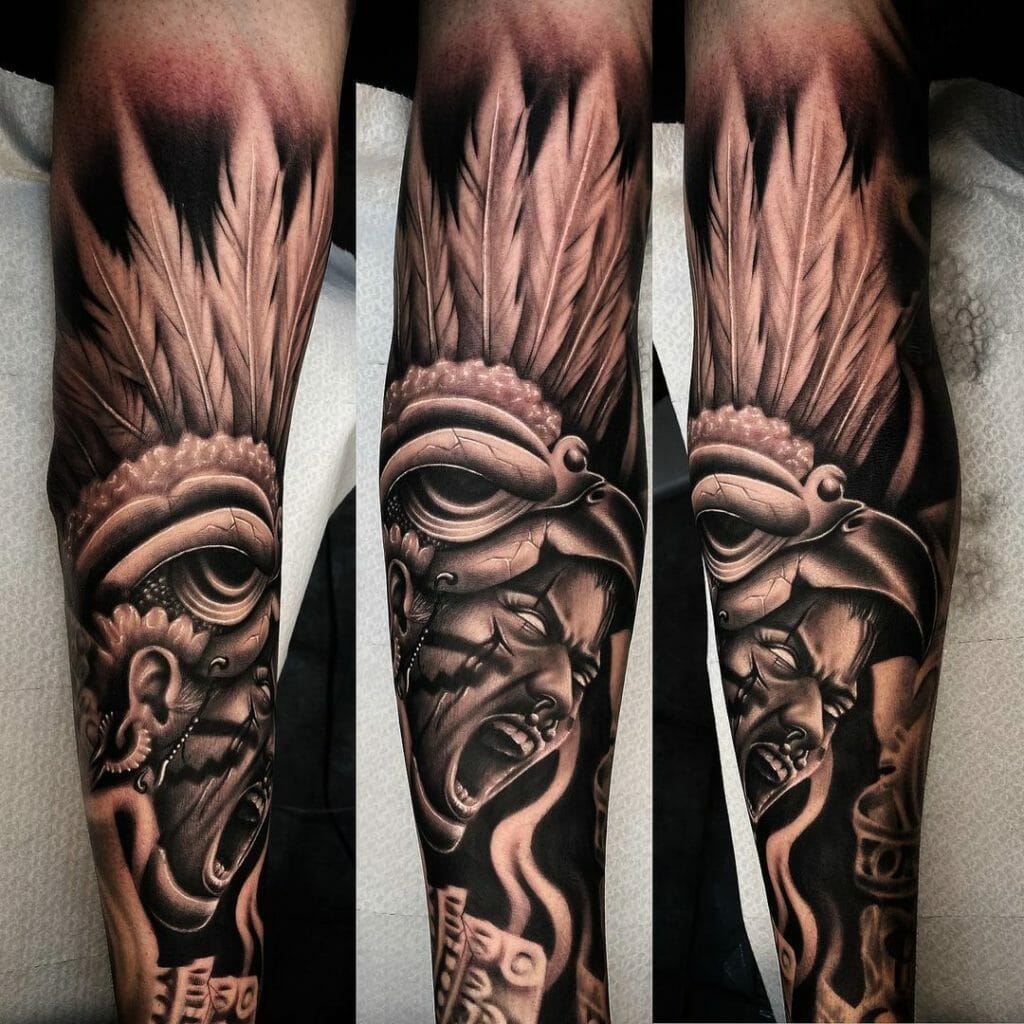
Unique Aztec Warrior Aztec Symbols Tattoos
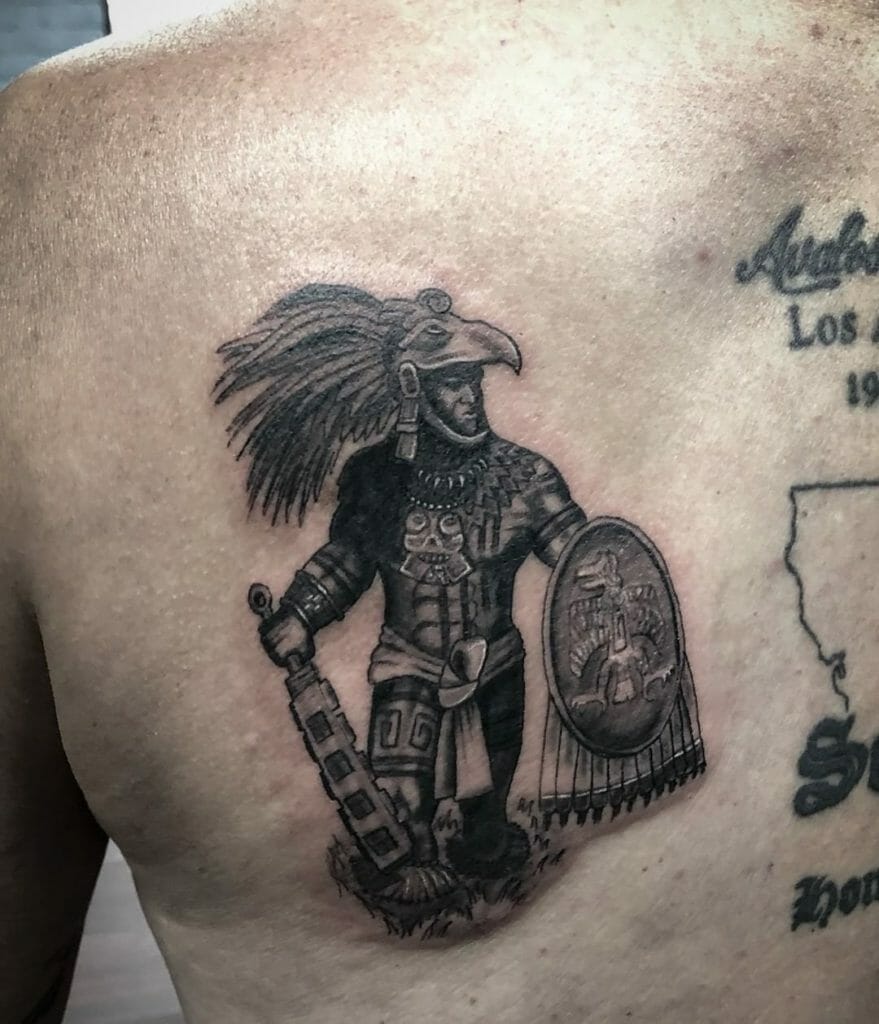
Aztec warrior tattoos are laden with profound meaning in their intricate lines, symbolizing struggle, resilience, and bravery. For those who have weathered life’s storms or traversed the fires of war, an Aztec warrior tattoo may resonate deeply. While many lean towards popular designs, like a warrior’s face or shield, exploring beyond these classics could lead to a richer blend of modern elements with traditional themes.
Famous Aztec Tattoos Representing Their Gods
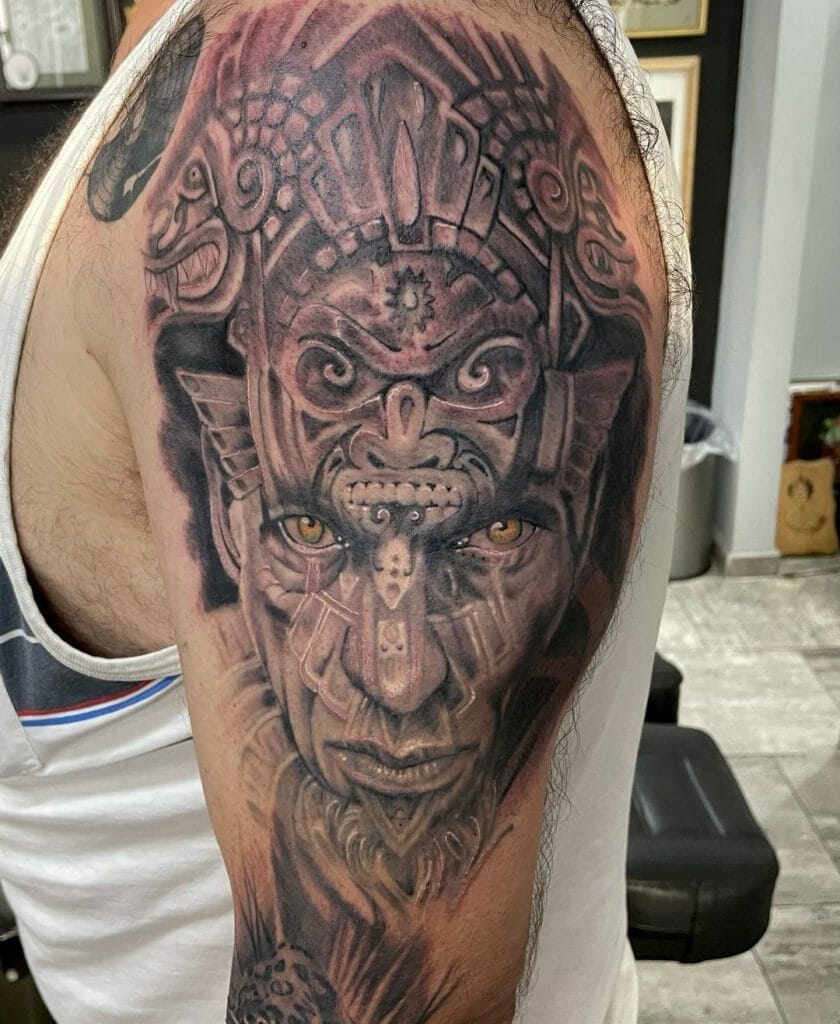
Aztec tattoos are a fascinating amalgamation of ancient mythology and cultural reverence. Designs often feature revered gods and symbolic creatures such as the Sun God, the Aztec eagle, or the mythical feathered serpent. Each carries a distinct significance, a rich narrative of a lost civilization. The Sun God, for example, was a vital figure in Aztec culture and religion, making it a popular choice for tattoo lovers. The Aztec symbol of the warrior tattoo, especially popular among people of Mexican or Central American descent, is not merely an emblem of bravery and courage but a testament to a relentless spirit and cultural identity.
Need More Inspiration







What Are The Specific Meanings Behind The Different Aztec Warrior Symbols?
Aztec culture and religion were replete with symbolism, and Aztec warriors often wore or carried these symbols into battle as part of their armament or uniform. These symbols carried specific meanings, often related to the gods they represented or the characteristics they were supposed to imbue in the warrior. Here are some of the key symbols associated with Aztec warriors:
- Eagle: The eagle was a symbol of the sun, the heavens, and the expansive sky. Eagle warriors were one of the two leading military orders in Aztec society, highly respected and feared by enemies. These warriors were known for their bravery and martial prowess. An Aztec eagle tattoo can represent strength, courage, and a connection to the divine.
- Jaguar: Jaguar warriors, like the eagle warriors, held a top-tier position in the Aztec military hierarchy. The jaguar was associated with the night, darkness, and the earth. As such, a jaguar tattoo might signify stealth, power, ferocity, and a deep connection with the natural world.
- Sun: The sun was a powerful symbol in Aztec culture, connected with the Sun God, Huitzilopochtli, who was also the god of war. The sun could represent life, light, and warmth, but also war, sacrifice, and conquest.
- Feathered Serpent (Quetzalcoatl): This deity was known as the god of wind, the sky, and learning. Quetzalcoatl was also considered a creator deity and the patron of priests. A tattoo of Quetzalcoatl might represent wisdom, creativity, and spiritual growth.
- Tezcatlipoca: This powerful god was associated with many aspects, including the night sky, ancestral memory, and obsidian. He was also seen as the god of the north, and a symbol of change through conflict. A tattoo featuring Tezcatlipoca could symbolize personal transformation, memory, and resilience.
- Aztec Warrior Headdress: Aztec warrior headdresses were adorned with the feathers of various birds and often bore other emblematic elements like animal skins or precious stones. These headdresses signaled the wearer’s rank, achievements, and the favor of the gods.
It’s essential to note that the precise interpretation of these symbols can depend on their context and the perspective of the person interpreting them. Therefore, if you’re considering getting an Aztec warrior tattoo, it would be advisable to research your chosen symbol’s meanings thoroughly and consider what it means to you personally.
What Is The Cultural And Historical Context Behind Aztec Warrior Tattoos?
The Aztec civilization, which thrived in the Valley of Mexico from 1300 to 1521, was characterized by rich mythology, intricate symbolic art, and fierce warfare. Tattoos were an integral part of Aztec culture and were used for various purposes such as signifying one’s societal status, military accomplishments, or religious devotions.
Aztec warrior tattoos carry a significant cultural and historical context, representing the valor, courage, and strength of these soldiers. Here’s a deeper look into this context:
- Status and Rank: Tattooing in Aztec culture was a way to depict one’s status and rank within the society. Aztec warriors often received tattoos as a reward for their bravery and achievements in battle. The complexity and scale of these tattoos often reflected the number of enemies a warrior had defeated.
- Religious Devotion: Aztecs were profoundly religious and worshipped numerous gods. Each god had specific symbols associated with them. Warriors often got tattoos of these symbols to show their devotion, gain protection in battle, or curry favor with a particular deity.
- Spiritual Connection: Aztec tattoos symbolized a connection to the spiritual world. Eagles and jaguars, considered divine creatures, were frequent tattoo subjects. Eagle warriors and Jaguar warriors were elite military orders in the Aztec society, and tattoos of these creatures symbolized the warrior’s spiritual connection to their chosen order and deity.
- History Preservation: Tattoos also helped preserve Aztec history and culture. Through detailed tattoos, stories of victories, mythology, and cultural traditions were passed down through generations.
The historical context behind these tattoos becomes evident when considering the Aztecs’ fall to Spanish conquerors in the 16th century. The descendants of the Aztec people and others interested in the culture often get these tattoos as a tribute to the civilization’s resilience, strength, and intricate cultural tapestry.
However, it’s essential to approach the adoption of Aztec tattoos (or any cultural symbols) with respect and understanding, acknowledging their origins, and the potential for cultural appropriation. Understanding the cultural and historical context behind Aztec warrior tattoos will only enhance their significance if you choose to incorporate them into your body art.
How Do Shading And Sketching Techniques Enhance The Intricacy Of The Tattoo Design?
Shading and sketching are instrumental techniques in tattoo artistry that greatly contribute to the overall effect and intricacy of a design. Here’s how they work:
- Depth and Dimension: Shading can give a two-dimensional image the illusion of three-dimensionality by creating a sense of depth. By adding different tones, a tattoo artist can suggest that certain parts of an image are receding into the background, while others are coming forward. This illusion of depth adds a degree of realism to the design.
- Texture: Sketching and shading techniques can also create texture in a tattoo design. Different techniques can be used to simulate the feel of surfaces, such as the roughness of a warrior’s shield, the softness of a feather, or the scales of a serpent, making the design more visually interesting.
- Contrast and Emphasis: Shading and sketching also play a vital role in contrast, which is a crucial element in any visual composition. It’s the difference in lightness and darkness between different parts of an image that allows us to distinguish forms. By using these techniques, a tattoo artist can emphasize or de-emphasize specific elements within the design, guiding the viewer’s eye across the tattoo.
- Realism: Shading is key in creating photorealistic tattoos. By applying ink more densely in certain areas and lighter in others, an artist can mimic the way light falls on an object, giving it a realistic appearance. This can make a tattoo design look like a black-and-white photograph, adding an incredible level of detail and complexity.
- Mood and Drama: Lastly, shading and sketching can also be used to create mood and drama. By manipulating light and dark areas, an artist can create a certain ambiance or emotional effect, making the tattoo not just visually stunning, but also emotionally engaging.
In the context of Aztec warrior tattoos, these techniques can be used to accentuate the warrior’s powerful physique, to create a sense of movement in a battle scene, or to bring to life the spiritual creatures and deities. With skilled shading and sketching, a tattoo artist can take a simple design and transform it into a dynamic and captivating piece of body art.
Conclusion
In conclusion, Aztec warrior tattoos offer a unique blend of rich historical symbolism and modern aesthetic appeal. They provide an avenue to express personal resilience, bravery, and connection to the past. While these tattoos carry deep-rooted significance, it’s essential to approach the process with due respect and understanding of the culture they originate from. When deciding on your tattoo, consider factors such as design complexity, color infusion, and placement, aligning them with your personal preferences and professional advice from your tattoo artist. Bear in mind that tattooing involves certain risks, including potential skin infections and allergies. Therefore, choosing a reputable, experienced, and hygienic tattoo artist is paramount. Always remember that your tattoo journey should be as unique as you are, and whether you choose an Aztec warrior, an Aztec god, or a symbol that resonates with you, this artistic venture should reflect your identity, heritage, or the values you stand for. It’s a commitment to carrying a piece of art — and history — with you forever. Embarking on this journey can be a deeply empowering and rewarding experience.
feature image from Pinterest



